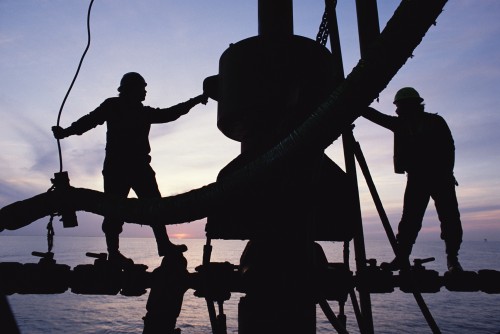
Double murder being investigated by authorities
September 19, 2012
Is drilling at pre-BP disaster levels yet?
September 25, 2012“A lot will depend on what happens in November,” Louisiana Oil and Gas Association President Don Briggs said regarding the petroleum industry’s condition and near future, as possibly influenced by the upcoming presidential election.
With fewer than 2,000 working rigs in the Gulf of Mexico, a stall in drilling permits and lease sales, and a president touting the benefits of alternative energy resources, Briggs is among the oil and gas professionals that are tentative in describing current conditions, but said future expectations would be influenced as much by need as independence.
Total U.S. petroleum deliveries – the measure that indicates consumer demand – fell 2.7 percent in July, to a little more than 18 million barrels a day, according to the American Petroleum Institute. It was the lowest level since 1995 and the lowest of any month since September 2008.
“While retail sales for July [were] up and housing has improved, the weak petroleum demand numbers are a strong indication the economy is still faltering,” API Chief Economist John Felmy said. “Unfortunately, achieving robust growth will likely continue to be an uphill climb given the nation’s fiscal challenges, business uncertainty and a European economy in jeopardy of sliding back into recession.”
The API economist said even with a decline in consumer use, refinery activity was strong throughout the summer. Production levels were at approximately 4.8 million barrels per day during July, which was the third highest level year-to-date. During the same month, total refinery input grew to its highest level thus far in 2012, at a rate of 2.3 percent.
Crude oil stocks were up more than 5 percent during July from the same month in 2011, but down 4.3 percent from June of this year. By the first of September, crude oil prices had rebounded nearly 3.5 percent and opened at $96.47 a barrel the morning following Labor Day.
An energy outlook release provided by ExxonMobil offers greater optimism. “In the decades ahead, the world will need to expand energy supplies in a way that is safe, secure, affordable and environmentally responsible,” ExxonMobil CEO Rex Tillerson said in a printed statement. “The scale of the challenge is enormous and requires an integrated set of solutions and pursuit of all economic options.”
ExxonMobil analysts predict that by the year 2040, global energy demands will be 30 percent higher than they were in 2010, based on the expectation of economic output having more than doubled during those three decades.
“The reality is we are an energy consuming country that has got to have oil and natural gas to survive,” Briggs said. “The one thing we can always count on in Louisiana, especially where we are positioned, is that we will be a major source and distributor of oil and natural gas products.”
Louisiana Mid-Continent Oil and Gas Association President Chris John shared a positive opinion regarding oil and gas industry improvements since the April 2010 BP Deepwater Horizon disaster, and what lies ahead for the Gulf of Mexico.
“I think the future of our oil and gas industry domestically and from a Louisiana standpoint is very bright,” John said. “There are a couple of indicators out there that truly underscore why people should be excited about the next five years, not only in the Gulf of Mexico, but onshore.”
John noted two bills that passed the 2012 Louisiana Legislature as beneficial for oil and gas. “One is dealing with legacy lawsuits,” he said. “That is a huge positive for re-investment in the state of Louisiana. The second kind of flew under the radar, but is a bill we as an association sponsored as the ultra-deep utilization bill. There is a lot of interest going to unbelievable depths onshore and in shallow water with depths of 25,000 to 30,000 feet. We needed to modernize our utilization laws to make it economical for these $100 million onshore wells. I think those two pieces of legislation have come back to benefit us in the oil and gas industry.”
For LSU economist Loren Scott, shale is the current not-so-secret to success for oil and gas. “The big news on the oil side is shale play,” he said.
Scott said mining shale has pushed North Dakota into a position of being the No. 2 oil producing state behind Texas. Oil production in North Dakota since 2003 is up by a factor of 66 reaching 60,000 barrels a day and growing.
As for Louisiana, Scott said he is watching the Tuscaloosa shale deposit between Alexandria and Baton Rouge, and extending into Mississippi. “We thought there would be a lot more rigs operating there than there is, but my conversations with people in the industry indicate that they have just about worked out fracking issues for shale,” he said. “In the next couple of years you will see a spike in both Louisiana and Mississippi.”
The Gulf of Mexico is not forgotten by Scott. “I think by 2013 you will have the same number of drill ships operating in deep water as you had [before the 2010 BP oil spill],” he said.
Briggs said that having established itself as an oil and gas resource not only in production, but in processing and transporting fuel, Louisiana holds a critical economic position that offers a more positive economic outlook than other parts of the nation.
“One of the big issues we are going to face as a country, that is going to have an impact on our industry in Louisiana, is the fact that we are going to be competing with China for energy supplies,” Briggs said. “Today, China is consuming almost 10 million barrels a day, but just a few years ago they were consuming only 2 million.”
The ExxonMobil report supported Brigg’s argument that now is the time to plan ahead regarding future market demands. “Decisions made decades ago to invest in technology, exploration and development [are] critical to meeting today’s energy demand,” the report said. It also noted that 75 percent of the oil being used in 2012 was actually discovered before 1980.
“I think as the economy starts to pick up little bit that brings along a positive in the oil and gas industry because of demand,” John added. “I think a second thing is to look at is the major oil and gas companies that are reaching out in deeper depths in the Gulf of Mexico. That is positive.”
During a recent personal conversation with Rep. Jeff Landry, President Barack Obama, while addressing the impact of Hurricane Isaac on Louisiana, mentioned a need to identify areas of the country that represent economic importance related to the United States as a whole.
“I jumped on that,” Landry (R-New Iberia) said. “I reiterated to him I thought that was a fantastic idea and that [Louisiana] represents an area that is vital to national interests.”
Landry told the president that the Gulf of Mexico produces a significant part of the nation’s petroleum resources. Additionally, the congressman said that 50 percent of the country’s refining capacity is situated along the Gulf Coast – 25 percent of which is in Louisiana.
“The areas we are talking about, and asking for money when it comes to hurricane protection, is one of those areas of national importance,” Landry said.
“I don’t see it as an issue of energy independence as much today as energy security,” Briggs said. “We have to be able to have the energy supply we need to run the engines of this country. We are an energy state. Our country needs the energy we produce in Louisiana for its national security.”
“A lot [of the petroleum industry outlook] hinges on November,” Landry said, echoing Briggs. “Regardless of the administration, the longer the price continues to tick upward it adds value to the economy down here. The way to stimulate the national economy as a whole would be to get those prices brought down somewhat, and have a robust drilling plan that would allow us to explore in the Gulf of Mexico while streamlining the permit process.”
Just as the most successful retail businesses depend on volume sales, these professionals agreed that increased production with reasonable prices would benefit the nation as a whole, while providing security to the oil and gas industry.
Like most industries, oil-and-gas workers are keeping an eye on the November presidential election. Oil exploration is still struggling to achieve pre-2010 drilling levels. Fewer than 2,000 workers are on rigs in the Gulf of Mexico, and the industry continues to undergo a stall in drilling permits and lease sales. Meanwhile, President Barack Obama continues to push alternative energy resources, leaving many tentative to predict the future.














